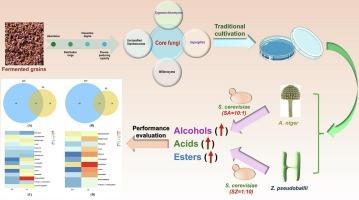Systematically exploring and evaluating core fungal composition and their flavor profile in fermented grains of Jiang-flavor baijiu
IF 8.2
1区 农林科学
Q1 CHEMISTRY, APPLIED
引用次数: 0
Abstract
Fungi play critical roles in the production of flavors during pit fermentation. To date, however, knowledge regarding core fungi in JFB remains limited. This study aimed to identify core fungi and evaluate their fermentation performance. Based on criteria including abundance, distribution range, interaction strength, and flavor-producing capacity, Zygosaccharomyces, Aspergillus, Millerozyma, and unclassified Dipodascaceae were identified as core fungi. Dominant species A. niger m6 and Z. pseudobailii J71 exhibited high metabolic activities. Co-culture systems of Saccharomyces cerevisiae J73 with Z. pseudobailii (SZ 1:10) and with A. niger (SA 1:0.1) enhanced the production of alcohols, acids, and esters. Compared with D35, the contents of certain flavor compounds were significantly higher in the SA and SZ co-culture systems. Collectively, this study firstly provides comprehensive exploration and evaluation of core fungi in JFB, establishing a preliminary foundation for constructing synthetic microbial communities and elucidating microbial interaction mechanisms during the production of baijiu flavors.

系统地探索和评价江味白酒醅中核心真菌组成及其风味特征
在坑式发酵过程中,真菌在风味的产生中起着至关重要的作用。然而,迄今为止,关于JFB核心真菌的知识仍然有限。本研究旨在鉴定核心真菌并评价其发酵性能。根据丰度、分布范围、相互作用强度和产味能力等标准,将Zygosaccharomyces、Aspergillus、Millerozyma和未分类的Dipodascaceae确定为核心真菌。优势种A. niger m6和Z. pseudobailii J71的代谢活性较高。酿酒酵母J73与假白耳曲霉(SZ:10)和黑曲霉(SA:0.1)共培养体系提高了酒精、酸和酯的产量。与D35相比,SA和SZ共培养体系中某些风味化合物的含量显著高于D35。总体而言,本研究首次对JFB核心真菌进行了全面的探索和评价,为构建合成微生物群落和阐明白酒香精生产过程中微生物相互作用机制奠定了初步基础。
本文章由计算机程序翻译,如有差异,请以英文原文为准。
求助全文
约1分钟内获得全文
求助全文
来源期刊

Food Chemistry: X
CHEMISTRY, APPLIED-
CiteScore
4.90
自引率
6.60%
发文量
315
审稿时长
55 days
期刊介绍:
Food Chemistry: X, one of three Open Access companion journals to Food Chemistry, follows the same aims, scope, and peer-review process. It focuses on papers advancing food and biochemistry or analytical methods, prioritizing research novelty. Manuscript evaluation considers novelty, scientific rigor, field advancement, and reader interest. Excluded are studies on food molecular sciences or disease cure/prevention. Topics include food component chemistry, bioactives, processing effects, additives, contaminants, and analytical methods. The journal welcome Analytical Papers addressing food microbiology, sensory aspects, and more, emphasizing new methods with robust validation and applicability to diverse foods or regions.
 求助内容:
求助内容: 应助结果提醒方式:
应助结果提醒方式:


